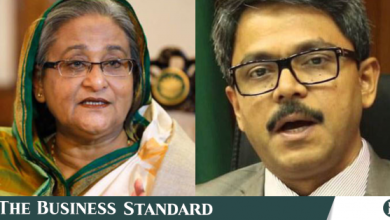Separate authority for leather industry on cards, govt unveils draft act


Officials concerned with the Act said the feedback from stakeholders will be considered before finalising the law
Infograph: TBS
“>
Infograph: TBS
The government has taken the initiative to establish a dedicated authority for the development and management of the country’s leather industry, the second-largest export sector.
Last week, the Ministry of Industries released a draft of the “Bangladesh Leather Industry Management Authority Act 2024” on its website, aimed at overseeing and fostering the growth of this critical industry.
The proposed authority will be responsible for establishing and managing both public and private leather industry zones, ensuring effective oversight and development initiatives.
Officials concerned with the Act said the feedback from stakeholders will be considered before finalising the law.
This move comes in response to demands from leather industry businesses and stakeholders for a separate entity under the Prime Minister’s Office to reduce dependence on the ready-made garment sector and diversify the country’s export portfolio.
Prime Minister Sheikh Hasina announced the formation of such an authority on 12 October last year, during the inauguration of the Bangladesh Leather Footwear and Leather Goods International Sourcing Show (BLISS 2023).
Four-member authority
According to the draft law, the authority will consist of a chairman and three members. The main office will be located in the Savar Leather Industrial Zone. The chairman will hold the rank of an additional secretary, and the members will be selected from joint secretary-ranked officials.
Eight-member board
The authority will operate under an eight-member board, chaired by the secretary or senior secretary of the Ministry of Industries, with the chairman of the Leather Industry Management Authority serving as the member secretary.
Other members will include the chairman of Bangladesh Small and Cottage Industries Corporation (Bscic), representatives from the Ministry of Environment, Forest and Climate Change, the Ministry of Commerce, the director of the Leather Engineering and Technology Institute at Dhaka University, the president of the Bangladesh Tanners Association, and the president of the Bangladesh Finished Leather, Leather Goods, and Footwear Exporters Association.
An official from the Ministry of Industries, seeking anonymity, told The Business Standard, “Stakeholders have long demanded a separate authority for the development and management of the leather industry. This authority will work on improving the sector and boosting exports.”
Welcoming the initiative, Md Sakhawat Ullah, general secretary of the Bangladesh Tanners Association and owner of Salma Tannery, said, “This is a timely decision. The authority should be formed quickly to facilitate immediate actions for the development of the leather industry.”
“Many steps have been taken for the industry’s development, but significant progress has not been achieved. If the new authority is formed, it will be possible to take immediate steps for the development of the leather industry, as a result, the plight of the leather industry will end,” he added.
To implement this authority’s objectives, as per the proposal, the board includes the director of the Leather Engineering and Technology Institute of Dhaka University as a member.
Talking on the matter, the current director of the Institute of Leather Engineering and Technology at Dhaka University, Prof Mohammed Mizanur Rahman emphasised the importance of this decision, saying, “Despite having a high-level task force involving various ministries, the industry hasn’t seen much progress.
“To develop the leather industry, this authority must take an independent and strong role. The authority needs to be empowered to ensure policy support, law enforcement, and compliance for the leather industry.”
He mentioned that in January of last year, the institute had sent letters to the Prime Minister’s Office and the Ministry of Industries to establish an independent agency called the “Leather Industry Directorate” to ensure proper oversight and increase export earnings of the leather industry.
“There is no alternative to forming a separate authority for the development of the promising leather industry,” he added.
In 2019, the government formed a task force comprising ministers, secretaries, and industry stakeholders to review and address the leather sector’s challenges.
The task force was assigned to review the overall state of the leather industry, identify existing problems, determine solutions, and provide recommendations for the industry’s development, market expansion, and export growth.
Stakeholders claim that despite the presence of this high-profile task force, which includes ministers, secretaries, and stakeholders, the leather industry has not seen significant improvement.
Govt plans same care for leather, jute as RMG
Prime Minister Sheikh Hasina has also instructed that the leather and jute industries receive incentives similar to those granted to the ready-made garments sector to boost export earnings from these sectors and reduce reliance on the garment industry.
The directive was issued during an informal cabinet meeting in Tungipara, Gopalganj, as revealed by Industries Minister Nurul Majid Mahmud Humayun and State Minister for Commerce Ahsanul Islam Titu in January this year.
The government currently offers export incentives ranging from 10% to 15% for leather products.
However, during the 1980s, the garment sector enjoyed a more substantial incentive of 25%, later reduced to 20% in the early 1990s. This significant support played a crucial role in propelling the garment industry to become the second-largest in the world.
According to the Export Promotion Bureau, leather and leather goods exports in FY2022-23 totalled over $1.22 billion, representing only 2.4% of that year’s export earnings.
In the first 11 months of the current fiscal year, the sector’s exports reached $961 million, which is 14.17% down compared to the same time of the previous fiscal year.




